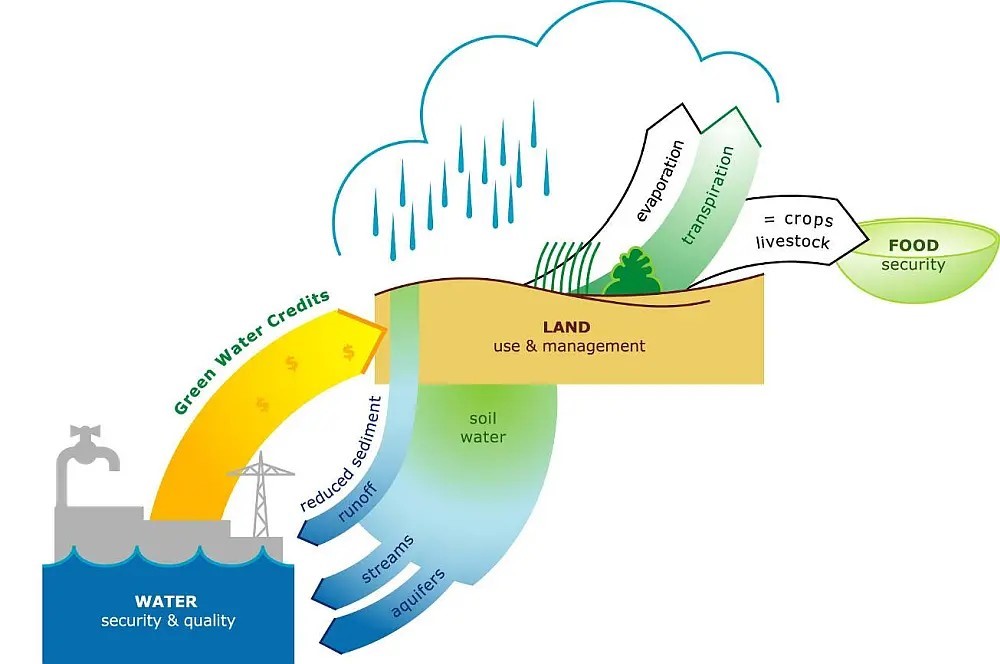Water Green Credits: A Sustainable Solution for Conservation
Syllabus:
GS-2:
Government Policies & InterventionsInternational Treaties & Agreements
GS-3:
Renewable Energy
Focus:
The Indian government’s Mission LiFE initiative has introduced Water Green Credits, modeled after carbon credits, to promote water conservation, rainwater harvesting, and efficient usage. This market-driven mechanism aims to address India’s alarming groundwater depletion by incentivizing industries, farmers, and individuals to optimize water use and trade conservation credits.
India’s Water Crisis: A Looming Threat:
Groundwater Depletion and Rising Demand
- India houses 18% of the global population but possesses only 4% of the world’s groundwater.
- Over-extraction of groundwater has led to a 25% decline in per capita availability over the past 70 years.
- A 2021 CAG report warns that if this trend continues, 80% of drinking water sources will be affected.
Agriculture’s Dominance in Water Usage
- 87% of groundwater extraction in India is used for agriculture, while domestic and industrial sectors account for 13%.
- Water-intensive crops, leaky irrigation networks, and inadequate wastewater treatment exacerbate the problem.
- Dams built before 1990 are now operating at less than 50% capacity, increasing reliance on groundwater.
Lack of a National Water Policy
- India lacks an integrated water policy to regulate extraction and conservation.
- Inefficient water management practices have worsened the situation, necessitating innovative solutions beyond traditional conservation methods.
Green Credit Program (GCP) – Key Highlights
About Green Credit Program (GCP):
- Market-based mechanism to incentivize voluntary environmental actions by individuals, communities, industries, and companies.
- Part of the ‘LiFE’ initiative announced at COP26, promoting sustainable lifestyles and environmental conservation.
Covered Activities (Eight Key Areas):
- Tree Plantation – Increasing green cover and preventing deforestation.
- Water Management – Efficient conservation and management of water resources.
- Sustainable Agriculture – Promoting eco-friendly farming practices.
- Waste Management – Implementing waste reduction and recycling initiatives.
- Air Pollution Reduction – Measures to improve air quality.
- Mangrove Conservation and Restoration – Protecting coastal ecosystems.
Governance and Administration:
- Managed by the Indian Council of Forestry Research and Education (ICFRE) under the Environment Ministry.
- Financial contributions directed to forest restoration, executed by State Forest Departments.
- After two years, an assessment assigns ‘Green Credits’ to successful projects.
Utilization of Green Credits:
- Compliance Mechanism – Offsetting forest land diversion by industries.
- Corporate Reporting – Fulfilling Environmental, Social, and Governance (ESG) and CSR obligations.
Green Credit Trading & Significance:
- Registry & Trading Platform established to track, manage, and trade Green Credits.
- Supports India’s environmental laws, climate commitments (COP26), and ecosystem restoration efforts (UN Decade 2021-2030).
- Operates independently of Carbon Credits but may generate climate co-benefits.
Water Green Credits: An Innovative Conservation Model:
Concept and Mechanism
- The Mission LiFE initiative by the government proposes a Water Green Credit Programme, inspired by the carbon credit model.
- It incentivizes water conservation, rainwater harvesting, and wastewater treatment by assigning tradable credits for reduced consumption.
How the Credit System Works
- Water-consuming entities (industries, businesses, farmers) optimize usage and earn credits for savings from their baseline consumption.
- These credits can be traded—entities exceeding water usage limits must purchase credits to offset their consumption.
- This market-driven model aligns economic interests with ecological responsibility, similar to carbon trading.
Implementation Challenges and Solutions:
Establishing a Robust Framework
- Key requirements for effective adoption:
- Define baseline water footprints.
- Set measurement and verification standards.
- Create a marketplace for credit trading.
- Establish pricing mechanisms balancing cost recovery, equity, and conservation.
- Regional factors such as rainfall, groundwater quality, and scarcity levels should influence credit valuation.
Role of Stakeholders
- Government bodies, agricultural associations, and water management agencies must ensure policies are tailored to local needs.
- International organizations and NGOs can provide expertise, funding, and advocacy.
Sectoral Impact: Beyond Industrial Use:
Agriculture: The Largest Beneficiary
- Water Green Credits can drive adoption of efficient irrigation techniques:
- Micro-irrigation & drip irrigation reduce water usage by 45% and increase yields by 114%.
- System of Rice Intensification (SRI) enhances productivity while conserving water.
- Soil moisture monitoring prevents overwatering, improving sustainability.
- Capacity-building and financial support are necessary, particularly for small farmers with fragmented landholdings.
Urban and Industrial Applications
- Encouraging rainwater harvesting for non-potable uses.
- Promoting greywater recycling for irrigation and toilet flushing.
- Integrating smart meters and leak detection technologies in homes and industries.
- Adoption of water-efficient appliances can contribute significantly to conservation.
Future Prospects and the Way Forward:
Key Steps for Effective Implementation
- Setting clear benchmarks for credit generation and issuance.
- Ensuring cross-sector fungibility to maintain flexibility in conservation efforts.
- Integrating digital platforms for registration, tracking, and monitoring of credits.
- Developing public-private partnerships to expand the model across industries and agriculture.
Collaborative Approach for Sustainable Water Management
- The success of Water Green Credits depends on collective efforts from government, industry, and agricultural communities.
- A structured credit system can drive sustainable agriculture, secure water resources, and reduce ecological stress.
- If widely adopted, the initiative can be a game-changer in India’s water conservation efforts, ensuring a sustainable future.
Conclusion:
Water Green Credits offer a market-based approach to tackle water scarcity, ensuring sustainable water management across agriculture, industries, and urban areas. Their success depends on strong policies, stakeholder participation, and technological integration. A well-implemented credit system can drive sustainable agriculture, secure water resources, and align economic growth with environmental responsibility.
Source: HT
Mains Practice Question :
Discuss the concept of Water Green Credits and their potential to address India’s water crisis. What challenges do they face in implementation, and how can a structured policy framework enhance their effectiveness? Suggest measures to ensure equitable water conservation across sectors. (250 words)




